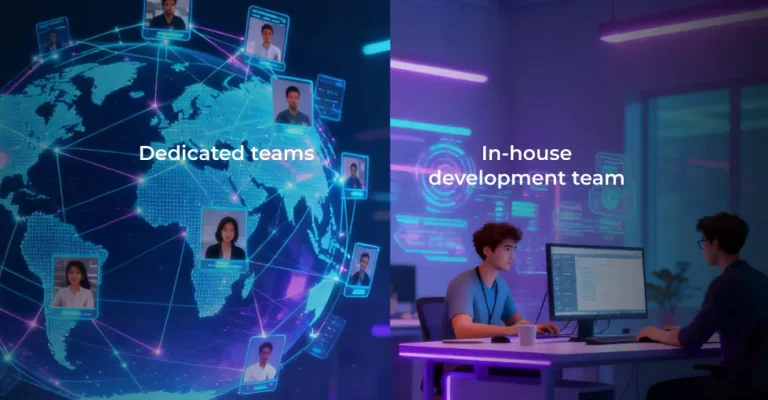In recent months, AI has been making headlines as the next major driver of productivity and cost savings. While intelligent automation holds enormous promise for boosting business performance, companies continue to rely on proven approaches — like outsourcing software development and design — to strengthen their digital initiatives.
This reliance is hardly surprising. Outsourcing has long become integral to business strategies that prioritize speed, flexibility, and operational efficiency. Today, over 90% of the world’s Fortune 500 companies maintain multiyear business process outsourcing (BPO) contracts, according to Kearney. Deloitte further notes that 94% of organizations building AI and machine-learning solutions engage outsourced service providers to develop or support those capabilities.
This software development outsourcing guide unpacks why remote tech expertise remains a cornerstone of digital execution and innovation. You’ll learn how leading companies use distributed engineering and design talent, which engagement models work best for different business needs, and what strategies can help you accelerate your initiatives, manage risks, and maximize long-term value.
What is software development outsourcing?
Software development outsourcing is a business practice in which a company delegates some or all of its engineering, design, or technical functions to an external partner. Instead of building and managing every capability in-house, organizations collaborate with specialized vendors who provide the skills, processes, and capacity needed to deliver digital products and solutions.
Done right, outsourcing can become a strategic extension of a company’s technology organization. It allows businesses to tap into global talent pools, scale teams quickly, reduce operational overhead, and accelerate delivery — all without the long recruitment cycles, training efforts, and infrastructure costs associated with internal hiring.
Main differences between in-house and outsourced software development
While both in-house and outsourced teams can deliver high-quality software, they operate under fundamentally different business conditions. Understanding these differences is essential for selecting the right approach — or the right combination — for your organization.
How in-house and outsourced teams compare:
- Control and oversight: In-house teams come with the advantage of direct, in-person management of priorities, processes, and communication. Outsourced teams require structured alignment through precise requirements, defined outcomes, and agreed-upon communication cadences.
- Cost structure: Internal teams come with higher long-term costs, including salaries, benefits, and infrastructure. Outsourcing converts many of these costs into flexible, on-demand expenses that scale with project needs.
- Speed and scalability: Hiring and scaling internal teams typically takes weeks to months. Outsourced vendors maintain ready-to-deploy talent pools, allowing companies to ramp up or down quickly as project demands change.
- Access to expertise: Local hiring can limit access to specialized skills for in-house models, though larger companies with a footprint across multiple tech hubs can partially mitigate this. Outsourced teams tap into global talent pools, often enabling faster and more targeted closure of open positions.
- Team dynamics and retention: In-house team performance and retention entirely depend on company culture and management. Outsourcing vendors handle team dynamics and retention, with the latter being typically very high among reputable firms that maintain a strong brand presence in remote locations.
- Time to market: Fully in-house teams can achieve fast delivery, but they are often constrained by budget and internal headcount. Outsourcing enables the engagement of additional resources or higher-seniority talent within the same budget, accelerating delivery.
- Adoption of latest-gen technology: The speed of in-house adoption of new technologies depends entirely on internal capabilities and budget. Top outsourcing vendors treat the adoption of cutting-edge tech as a competitive advantage, often demonstrating high proficiency with the latest tools, programming languages, and frameworks.
- Onboarding of new hires: In-house onboarding speed varies by company and process efficiency. Remote vendors often view rapid and smooth onboarding as a differentiator and focus on making it faster and more efficient than most internal processes.
- Risk profile: Internal teams assume all delivery, capacity, and operational risks. Outsourcing redistributes some of these risks to the vendor, who is accountable for execution, continuity, and process maturity.
- Strategic focus: In-house staff are best positioned to work on core intellectual property (IP) and long-term product strategy. Outsourced teams complement that work by handling specialized, time-sensitive, or operational tasks that might otherwise slow internal teams.
Key outsourcing models
When working with remote development vendors, companies can choose from multiple engagement models ranging from staff augmentation to project-based outsourcing. Each model offers distinct benefits depending on your company’s goals, project scope, and desired level of control.
Staff augmentation
In a staff augmentation setup, external development, AI, data, software quality assurance, or design experts are integrated into your internal team and process. You maintain direct control over tasks, priorities, and project management, while the augmented staff provides the expertise and capacity needed to meet specific project requirements. This model allows companies to scale their capabilities quickly without dealing with the long-term costs and complexities of full-time hires.
When to use:
Staff augmentation works best for projects that require tight integration with in-house teams or temporary capacity increases — such as during major feature releases, product launches, or critical maintenance periods. Hybrid teams that combine in-house and external professionals in the same delivery pipelines typically rely on staff augmentation.
Managed team
A managed team is a group of external developers who work exclusively on your projects but operate under the vendor’s management and processes. While you maintain strategic oversight, define project goals, and get granular performance reports, the vendor handles day-to-day team management and process organization. This model is commonly associated with the dedicated team pricing structure and is often referred to by this term.
When to use:
Managed teams are optimal for medium- and long-term projects or ongoing product development, where continuity and an ownership mentality are critical. Consider this model when you need a fully committed, cohesive, and self-sufficient team that can operate as an extension of your organization without your internal managers handling every detail.
Managed services (custom solution development)
In the custom solution development model, the vendor takes full responsibility for delivering a software product or system — from discovery, design, and architecture through development, QA, and deployment. You set the business goals and success criteria, and the vendor manages execution end-to-end, using its own processes, leadership, and delivery frameworks.
When to use:Managed services are best suited for projects that require a specialized, outcome-driven partner toown the entire delivery process, such as building a new product from scratch, modernizing a legacy platform, or executing a complex initiative that requires cross-functional expertise. It’s also a strong fit when internal resources are limited, and you want predictable delivery with clear ownership.
| Business requirements | Architecture | Hiring and team assembly |
| Initial UI/UX and research | High-level infrastructure | Ongoing development and design activities |
| Project scope | UX/UI prototyping | Infrastructure development (e.g., CI/CD, DevOps) |
| Product roadmap | Development strategy | Team management |
| Reporting | ||
| Staff augmentation | ||
| Managed team | ||
| Managed services (custom solution development) | ||
Technology consulting
While technically a standalone group of services, technology consulting often overlaps with outsourced software development — either shaping the groundwork for a future build or guiding an ongoing initiative with high-level expertise. Consultants assess your current systems, architecture, workflows, and product strategy, then provide recommendations on technology choices, delivery approaches, team structure, and long-term roadmaps.
When to use:
Technology consulting is ideal when you need clarity before committing to development — for example, evaluating the feasibility of a new product idea, selecting the right tech stack, defining an MVP scope, planning a cloud migration, or assessing scalability and performance issues. It’s also valuable when internal teams need guidance on best practices, architecture decisions, or modernizing outdated systems.
Key pricing models
Choosing the right pricing model is essential for setting expectations, managing risk, and aligning delivery with your budget. Each model offers different levels of flexibility, predictability, and control, making some better suited for exploratory projects and others for well-defined scopes.
Fixed price
In a fixed-price model, the vendor commits to delivering a clearly defined scope for a predetermined cost. This approach offers maximum predictability but requires detailed requirements upfront. It works best for smaller, well-scoped initiatives where changes are unlikely.
Time & material (T&M)
With T&M, you pay for the actual hours and resources used. This model provides flexibility to adjust priorities, iterate, and refine requirements during development. It’s a strong fit for evolving products, long-term roadmaps, or initiatives where discovery continues alongside delivery.
Dedicated team
A dedicated team model typically involves a fixed monthly cost for a cross-functional team (or individual experts) working exclusively on your project. This model gives you predictable budgeting combined with the ability to scale the team or shift focus as needed — ideal for ongoing product development and multi-phase initiatives.
Less common models
While not used as frequently, several additional pricing structures appear in specific scenarios:
- Cost plus/Open book: You pay actual costs (salaries, overhead) plus an agreed margin; suited for long-term, transparent partnerships.
- Retainer: A recurring fee secures access to a set number of hours or services each month.
- Milestone-based: Payments are tied to the completion of predefined deliverables.
- Value- or incentive-based: Pricing is linked to business outcomes, performance metrics, or shared risks and rewards.
Types of outsourcing strategies based on location
Where your outsourcing partner is located has a significant impact on collaboration, cost, communication, and the overall delivery process. Companies typically choose among four geographic models, each with its own advantages depending on your budget, operational preferences, and need for real-time interaction.
Onshoring
Onshoring involves working with agencies and dev firms located in the same country as your business. This option offers the highest level of alignment across time zones, cultures, languages, and regulatory environments. While typically the most expensive model, it minimizes communication friction and is well-suited for industries with strict compliance requirements or projects that require close, synchronous collaboration.
Nearshoring
Nearshoring means partnering with teams in nearby countries with similar time zones (e.g., 4+ hours of overlap). For U.S. companies, this often includes Latin America; for Western Europe, Central and Eastern Europe. Nearshoring provides a strong balance between cost efficiency and ease of collaboration, with overlapping working hours, cultural proximity, and faster travel if in-person sessions are needed.
Offshoring
Offshoring refers to partnering with teams in more distant regions — historically Asia, but now also expanded to Africa. This model offers the lowest cost, but often requires more coordination due to time zone differences. It works best for companies with mature processes, clear documentation, or 24/7 operations that benefit from distributed work cycles.
Reshoring (inshoring)
Reshoring (or inshoring) means bringing previously outsourced work back into your home country. Companies consider this when they need tighter oversight, face new regulatory demands, or want to strengthen internal capabilities. While more costly, it can improve control, compliance, and internal knowledge retention.
Top outsourcing destinations
While outsourcing is now a global practice, certain regions have emerged as leading hubs due to their talent availability, cost structure, technical expertise, cultural compatibility, and business environment. The best destination depends on the complexity of your project, collaboration needs, and budget.
Latin America (LATAM)
LATAM has become a premier outsourcing destination for U.S. companies thanks to its strong time-zone alignment, growing pool of senior engineers, and improving English proficiency. Countries like Argentina, Brazil, Colombia, and Mexico offer competitive rates, high-quality technical education, and strong experience with U.S. enterprise environments. The region is particularly well-suited for teams that require real-time collaboration or Agile development.
Eastern and Central Europe (CEE)
Countries such as Poland and Ukraine (and lately Romania, Slovakia, and Slovenia) have long been recognized for deep engineering expertise backed by strong STEM education. CEE offers a balance of cultural alignment with Western clients, experience with complex enterprise systems, and competitive pricing. This region is optimal for companies seeking advanced technical capabilities spanning frontend, backend, and mobile development, AI/ML, data engineering, cybersecurity, and more.
Asia
Asia — including India, Vietnam, the Philippines, and increasingly Indonesia and Malaysia — remains one of the most cost-competitive outsourcing regions. India leads with massive talent availability and strong expertise across enterprise technologies, while Southeast Asian countries are gaining traction for high-quality engineering at lower price points. This region can be a strong fit when cost savings are a priority, and companies have the processes and structure to support distributed collaboration across significant time zone differences.
Typical business challenges that outsourcing can solve
Software development outsourcing helps companies address a wide range of operational, technical, and strategic challenges. Whether the goal is to accelerate delivery, expand capabilities, or manage uncertainty, working with external experts can remove bottlenecks that internal teams aren’t structured to solve on their own.
Optimizing resources
Outsourcing helps organizations achieve more with the same (or smaller) budgets. By tapping into global talent markets, businesses can engage senior experts at competitive rates, reduce overhead, and avoid the long hiring cycles associated with full-time roles.
Accessing niche expertise
Many companies struggle to find specialists for emerging technologies or niche skill areas locally. Outsourcing enables fast access to engineers with experience in AI/ML, data engineering, cloud, cybersecurity, Rust, low-level systems, or other hard-to-hire capabilities.
Building digital solutions from scratch
Suppose a team doesn’t have the capacity or skills to build a new application internally. In that case, outsourced engineers can take full ownership of development — from discovery and architecture to launch and support — accelerating time-to-market and reducing execution risk.
Driving innovation and modernizing legacy systems
Legacy systems often slow down product evolution. Outsourcing connects companies to modernization specialists who can re-architect outdated platforms, implement new technologies, and guide the adoption new architecture approaches such as microservices, micro-frontends, or multicloud.
Scaling or optimizing existing solutions
Outsourcing is an effective approach when a product’s infrastructure or architecture needs targeted performance improvements, refactoring, or scalability upgrades. External engineers can optimize high-load components, improve database efficiency, and pay down technical debt — work that often requires niche expertise in distributed systems or high-performance backend engineering.
Maintaining round-the-clock operations
Outsourcing enables true 24/7 coverage by distributing work across global time zones. Teams in regions like India can support a follow-the-sun model, ensuring rapid incident response, continuous development, and software testing without placing additional strain on local staff.
Staying competitive
As more organizations adopt outsourced models, relying solely on local hiring can slow innovation. Working with experienced remote teams enables companies to match or exceed the delivery pace of competitors who already leverage global talent.
Pros and cons of outsourcing
Outsourcing software development offers significant benefits, but it’s not without trade-offs. Understanding both the upside and potential pitfalls can help organizations make informed decisions and choose the right approach for their goals.
Key benefits
- Global talent pool: Outsourcing expands talent engagement strategies beyond national borders, improving hiring outcomes.
- Cost savings: According to the IT Outsourcing Market Overview by Global Growth Insight, 72% of companies outsource primarily to reduce costs. Outsourcing minimizes recruitment, benefits, and infrastructure expenses while leveraging cost-efficient regions.
- Scalability and agility: The same report notes that 61% of companies cite agility and scalability as key advantages of outsourcing. Distributed teams allow organizations to adjust capacity up or down with minimal HR, recruitment, or operational overhead.
- Faster time-to-market: By engaging additional or higher-seniority resources within the same budget and leveraging the vendor’s proven delivery strategies, companies can often accelerate development timelines by 2x or more.
- Flexibility: Companies can leverage distributed teams for 24/7 development cycles, ad hoc projects, or experimental proofs of concept without overextending internal resources.
- Focus on core business objectives: Internal teams can concentrate on strategic initiatives, while outsourced experts handle maintenance, integrations, or specialized technical work.
- Adoption of latest technologies: Top vendors maintain expertise in modern frameworks, languages, and platforms, providing capabilities that may be difficult to build internally.
- Streamlined process management: Leading outsourcing firms bring mature delivery frameworks, structured workflows, and robust reporting practices. They standardize sprint planning, progress tracking, and more, which reduces operational overhead for your internal team.
- Risk mitigation: Outsourcing shifts certain operational and technical risks to the vendor, which is accountable for delivery, continuity, and adherence to processes. This can reduce exposure to resource shortages, technology gaps, and compliance or market uncertainties.
Key risks
- Vendor lock-in: Relying too heavily on a single vendor can create unnecessary dependencies and limit flexibility.
- Cultural and language barriers: Differences in communication style, work culture, or time zones can cause friction if not proactively managed.
- IP and data security risks: Sharing sensitive information requires strict security, contracts, and governance.
- Quality control: Not all vendors maintain the same standards; poor-quality work can lead to delays and increased costs.
- Hidden costs: Scope changes, onboarding, or misaligned expectations can increase total spend.
- Loss of direct control: Outsourcing may reduce day-to-day oversight and require strong governance processes.
Reputable, high-quality outsourcing firms implement measures to minimize or mitigate these risks. Proper documentation and project hand-off protocols reduce dependence on a single team or vendor, while IP and data protection measures are typically explicitly defined in contracts. Leading vendors also provide transparency into costs and processes, giving clients granular control and oversight when needed.
Choosing the right vendor
Selecting the right outsourcing partner requires evaluating factors that directly influence delivery quality, transparency, collaboration, and long-term maintainability. Using the following criteria, companies can compare vendors objectively and understand how each potential partner manages its operations, safeguards IP, and supports efficient knowledge transfer.
Size and structure
Vendor size affects delivery capacity, flexibility, and operational maturity. Larger firms (typically 500+ engineers) offer broader technical coverage, established processes, and the ability to scale teams quickly. Smaller boutique vendors (usually under 200) tend to focus more on senior-leaning teams, faster decision-making, and closer day-to-day collaboration.
Industry and technical expertise
Teams generally onboard faster when a vendor has delivered similar solutions in the same industry. Reviewing case studies and relevant project experience helps confirm whether the vendor can navigate the technical and domain-specific challenges of your product.
Location and time zone alignment
Time zone proximity affects how much real-time collaboration teams can maintain. Nearshore partners (e.g., LATAM, Central Europe for the U.S. East Coast) provide overlapping hours that support agile development. Offshore teams (e.g., in India) can continue work after your in-house team’s day ends, enabling true follow-the-sun progress.
Data protection and IP policies
Clients can evaluate security and IP safeguards through both documentation and certifications. When considering an outsourcing collaboration, companies can look for certifications such as ISO/IEC 27001 or SOC 2 as indicators that a vendor follows mature governance and security practices. Contracts should also clearly define IP ownership, confidentiality obligations, and data-handling practices. Reviewing these elements upfront gives clients confidence that their assets are protected.
Communication and project management
Clear communication is essential to maintaining velocity and transparency. Evaluating a vendor’s reporting cadence, tooling, escalation paths, and stakeholder-management approach provides insight into how smoothly collaboration will run. Mature vendors offer structured updates, proactive risk communication, and tooling that integrates cleanly with the client’s infrastructure.
Knowledge transfer and documentation practices
Effective knowledge transfer ensures teams remain resilient and the client avoids dependence on specific individuals. When evaluating potential vendors, inquire about their documentation standards, onboarding and offboarding workflows, and structured hand-off protocols. Vendors with strong practices maintain clear internal knowledge bases and ensure continuous documentation throughout the project lifecycle.
Cultural fit and collaboration style
Cultural alignment affects everything from decision-making speed to conflict resolution. Understanding how a vendor approaches feedback, ownership, initiative, and communication helps determine how well the teams will mesh in practice. Vendors that demonstrate transparency, accountability, and a compatible collaboration style typically integrate more smoothly with internal stakeholders.
Red flags to watch out for
- Overpromising on delivery timelines or capabilities
- Rates that are significantly below the market, unclear pricing, or hidden fees
- Shaky track record with missing or limited references
- Slow or otherwise inadequate communication (e.g., bad English, too many points of contact)
- Discouraging the client’s participation in interviews or poor candidate selection (such as providing candidates whose skills or seniority don’t match the project)
- Lack of transparency or reporting
- High staff turnover
Choosing the right vendor involves balancing technical expertise, process maturity, and cultural fit. A well-selected partner not only delivers the required work efficiently but also becomes a strategic extension of your internal team.
The IT services you can outsource
Outsourcing isn’t limited to software development or design execution. Companies can leverage external partners for a wide range of IT services, including strategic and tactical activities that involve technology assessment, research, audits, and more. While not exhaustive, the following list highlights the main services typically offered by remote development firms.
- Audits and assessments: Vendors can evaluate your current systems, processes, and technical architecture to identify inefficiencies, risks, and opportunities for improvement. These assessments provide a foundation for planning modernization or expansion initiatives.
- Product discovery and roadmapping: External teams can help shape product strategy, validate assumptions, and prioritize features based on market research, technical feasibility, and business goals.
- Proof of concept (PoC) and MVP development: Vendors can quickly build experimental solutions to validate ideas, test technologies, or explore new business models before committing significant internal resources.
- Custom software development: From web and mobile applications to complex enterprise systems, outsourcing companies provide end-to-end development services while adhering to deadlines and budget constraints.
- Technology consulting and advisory: Consulting engagements can include architecture reviews, technology selection, cloud strategy, and guidance on best practices. While technically a separate service, consulting often involves outsourced development or prototyping.
- Managed IT services: Vendors can oversee operations such as system monitoring, maintenance, patch management, and help desk support, ensuring stability and freeing internal teams for strategic projects.
- Data analytics: Outsourced teams can build or optimize data pipelines and deliver systems that power analytics, reporting, visualization, AI-driven business intelligence, and more.
- AI/ML consulting and development: Vendors provide expertise in AI model development, machine learning pipelines, and integration into business workflows, accelerating the adoption of cutting-edge technologies.
- Cloud consulting and engineering: From cloud migration to architecture optimization and multi-cloud management, external partners can enhance efficiency, scalability, and reliability.
- IoT development: Vendors can design, develop, and deploy IoT solutions, including device integration, connectivity, and cloud platforms.
- Cybersecurity: Outsourced teams can provide vulnerability assessments, penetration testing, incident response, and compliance management, strengthening overall security posture.
- Quality assurance and testing: Vendors can implement automated and manual testing strategies to cover functional, performance, security, and usability testing, ensuring robust, reliable software.
- DevOps (DevSecOps, MLOps, AIOps, etc.): External teams can establish or optimize operational practices, pipelines, and monitoring to accelerate delivery while maintaining quality, compliance, and security.
- Low-code/no-code development: Vendors help rapidly build internal tools, workflows, or prototypes using low-code platforms, reducing time-to-market for non-core applications.
- UX/UI design: Outsourced design teams provide user research, interface design, interaction design, and usability testing to ensure products are intuitive, engaging, and aligned with business objectives.
IT outsourcing process: key steps and how to start
Outsourcing works best when approached as a structured, collaborative workflow. The steps below outline the main phases in an outsourcing engagement — from initial planning to long-term delivery.
- Goal-setting: Clarify what you want to achieve — accelerating delivery, scaling your team, modernizing a product, or accessing specialized talent. Define the technical domains involved, constraints, and success metrics to guide all subsequent decisions.
- Choosing and evaluating vendors: Shortlist potential partners based on technical expertise, industry experience, security standards, delivery processes, and pricing models. Location considerations — including time zone overlap, talent availability, and cost — can also influence your vendor choice.
- Discovery: Use this phase to explore business needs, validate assumptions, map dependencies, and assess feasibility. This phase can precede or follow contract negotiation, depending on the specific model or vendor you’re working with.
- Contract negotiation: Align on pricing, SLAs, payment terms, engagement conditions, and exit provisions. Include explicit agreements on data privacy, IP ownership, confidentiality, and security practices to ensure a solid legal and operational foundation.
- Setting expectations for budget, timeline, and milestones: Confirm the budget, delivery roadmap, sprint cadence, reporting routines, and acceptance criteria. Precise alignment prevents scope creep and keeps stakeholders on the same page.
- Formalization of scope and requirements: Based on insights from discovery, document functional and nonfunctional requirements, user flows, architectural constraints, integration points, and acceptance criteria. A well-structured scope ensures clarity for design, development, and testing while reducing miscommunication and rework.
- Candidate interviews: For models where you select individual engineers or designers, interview candidates provided by the vendor to verify technical skills, communication style, and cultural fit. This step helps ensure cultural fit and personality match, which can be as critical as seniority or technical skills.
- Project kick-off: The vendor onboards the remote team, syncs tools and environments, establishes communication channels, and confirms roles and responsibilities. Consider starting with a pilot milestone to validate collaboration, velocity, and quality before scaling up.
- Design, development, and QA: The vendor collaborates iteratively with your team through design, implementation, and testing cycles. Regular updates, sprint reviews, and retrospectives help ensure work aligns with your business goals while maintaining transparency and quality.
- Delivery and deployment: The vendor prepares production-ready artifacts, documentation, and release notes. Deployment strategies, roll-out timing, and verification steps are coordinated with your team to ensure a smooth launch.
- Release: The solution is launched into the target environment, with both teams monitoring stability, validating KPIs, and addressing any post-deployment issues.
- Support and maintenance: The vendor continues to provide bug fixes, updates, enhancements, and performance optimization, supporting the long-term roadmap. High-quality partners remain active contributors, ensuring the solution evolves according to business needs.
Software development outsourcing best practices
Maximizing the value of an outsourcing engagement requires more than selecting a reputable vendor — it also involves setting up transparent processes, aligning expectations, and monitoring performance throughout the partnership. The following best practices help executives and managers ensure their investments deliver tangible business outcomes.
Invest time in vetting vendors
Invest adequate time and effort in assessing your potential partner’s technical expertise, process maturity, and cultural compatibility. Shortlist multiple candidates based on portfolios, client testimonials, and, where possible, live references. Make the final selection by considering both their experience and how well their team culture aligns with your internal stakeholders.
Make the discovery phase count
A thorough discovery phase helps your outsourcing partner fully understand your goals, current systems, constraints, and priorities. Use this phase to clarify expected deliverables and uncover potential risks before development begins. Done right, the discovery session prevents misalignment on requirements, which can be a significant pain point for collaborations focused on outsourcing.
Define clear KPIs and success metrics early
Establish measurable indicators such as delivery timelines, quality standards, system performance, and responsiveness to requests. Setting clear KPIs from the start allows you to monitor progress and ensure the partnership meets expected performance levels.
Focus on ROI
Continuously monitor and evaluate collaboration with your outsourcing partner while keeping ROI front and center. Assess whether the engagement is delivering efficiency, cost savings, faster time-to-market, or other tangible benefits relative to the investment.
Ensure proper documentation and knowledge transfer
Require the vendor to maintain detailed design documents, code comments, and operational manuals. Clear knowledge transfer procedures, onboarding, and offboarding protocols reduce dependency and ensure continuity if team members change.
Maintain control over product-market fit and strategic decisions
While vendors handle technical execution, your internal teams should lead on product vision, market positioning, and key strategic choices to protect business objectives.
Align on cultural and process practices
Encourage a collaborative environment by clarifying communication channels, reporting cadence, escalation paths, and feedback mechanisms. Teams that understand each other’s working style integrate more smoothly.
Outsource non-core or specialized tasks
Assign your internal team to high-value, strategic initiatives while outsourcing maintenance, technical spikes, PoCs, or specialized areas like AI, cloud, or security to external experts. Done strategically, this practice is integral to hybrid teams that combine in-house and external capabilities into cohesive, well-tuned delivery models.
Choose vendors who can tailor their approach
Select partners who can adapt their engagement model, team management style, and process coordination to your company’s size, industry, project needs, and governance structure. Flexible vendors ensure the outsourcing arrangement scales effectively with your business.
Continuously monitor and optimize performance
Regularly review milestones, team performance, budget adherence, and alignment with KPIs. Share relevant reviews with your vendor to keep everyone on the same page and make adjustments to resources, scope, or processes as needed. Tracking progress effectively requires identifying the right metrics — across delivery, quality, business, and operational dimensions — which can then guide data-driven decision making and performance optimization:
| Metric Category | Purpose | Key Indicators |
| Delivery | Measure the speed and efficiency of development | Cycle time, deployment frequency, and lead time for changes |
| Quality | Assess the stability and reliability of work | Defect escape rate, customer-reported bugs, test coverage |
| Business | Track value delivered to the organization | Time-to-market for features, revenue impact, NPS/CX impact |
| Operational | Evaluate reliability and partner performance | SLA adherence, mean time to recovery (MTTR), and team attrition rate |
Software development outsourcing costs
When comparing developer salaries in the U.S. to the rates charged by outsourcing vendors, companies can expect a 50% to 70% difference for comparable experience, seniority, and expertise. That being said, understanding outsourcing costs is more complex than a simple rate comparison, as fees and cost structures vary by engagement model, project scope, and required skills.
- Pricing by engagement model: Costs vary depending on how you engage your remote experts. Staff augmentation and managed teams are billed at fixed hourly or monthly rates per resource, providing budget predictability. Fixed-price contracts provide cost certainty for well-defined projects, while time-and-material (T&M) arrangements offer flexibility for projects with evolving requirements.
- Pricing by location: Rates vary by location due to labor costs, market conditions, and currency differences. Offshore locations such as India are the most cost-competitive, nearshore regions like LATAM and Eastern Europe balance cost with time-zone overlap and cultural proximity, and onshore or local vendors are generally the most expensive.
- Complexity and expertise: Projects requiring advanced technologies, niche skills, or senior resources—such as AI/ML, cloud architecture, IoT integration, or enterprise systems—typically command higher pricing.
- Additional considerations: Beyond base rates, overall costs may include onboarding and ramp-up time, licensing fees, travel, compliance audits, and dedicated project management. High-quality vendors provide clear, transparent breakdowns to help avoid hidden costs.
Understanding these variables allows executives and managers to plan budgets accurately, compare vendor offerings, and align outsourcing investments with strategic business objectives.
Common software development outsourcing myths and misconceptions
Outsourcing software development often comes with misconceptions that can prevent companies from fully leveraging remote expertise. Understanding the realities behind these myths helps executives make informed decisions and avoid unnecessary concerns.
Myth 1: Outsourcing is only about cost reduction
Reality: While cost savings are a major benefit, outsourcing also unlocks a slew of other advantages — especially when managed properly. Top vendors help businesses accelerate critical initiatives, innovate at scale, and move fast under pressure, which goes well beyond simply cutting expenses.
Myth 2: Outsourcing compromises quality
Reality: In practice, reputable vendors maintain mature engineering processes, robust QA practices, and strong internal oversight. Quality lapses usually stem from poor vendor selection or insufficient governance, not outsourcing itself.
Myth 3: In-house teams are always more skilled
Reality: Internal developers understand company culture and domain knowledge, but that doesn’t automatically make them more technically capable. Many outsourcing partners employ specialists with deep expertise in modern or niche technologies and architectures, as well as advanced engineering techniques. These capabilities complement, rather than compete with, in-house teams — enabling higher overall delivery quality.
Myth 4: You lose control over your project
Reality: Companies sometimes worry that outsourcing limits visibility or influence. In fact, well-run engagements rely on structured reporting, clear decision-making frameworks, shared tooling, and predictable communication rhythms. With the right processes in place, you retain strategic control while the vendor handles execution.
Myth 5: Freelancers (e.g., platforms like Upwork) are equivalent to outsourcing
Reality: While freelancers can be exceptionally skilled, the freelancing model does not provide the same reliability, process rigor, or scalability as working with a professional outsourcing firm. Outsourcing brings organizational structure, quality assurance, and accountability that freelancing can rarely deliver.
Myth 6: Outsourcing prevents collaboration with internal teams
Reality: Modern outsourcing is highly collaborative. Remote engineers can join agile ceremonies, participate in architecture discussions, and work within your toolchain. With proper onboarding and aligned processes, external teams can function as an integrated extension of your engineering organization.
Outsourcing pain points and how to solve them
While many perceived negatives of outsourcing are myths, real pain points do exist. Challenges such as miscommunication, onboarding delays, or misaligned expectations require proactive management and dedicated resources to ensure the engagement runs smoothly. The following guidance highlights common pain areas and practical ways to address them.
Communication breakdowns
Communication issues are one of the most common sources of frustration in outsourcing — whether it’s slow responses, unclear updates, or mismatched expectations.
How to solve it: Establish communication channels, cadences, and escalation paths upfront. Align on tools, meeting frequency, documentation standards, and decision-making frameworks. Reliable vendors maintain predictable reporting rhythms and proactively flag risks, which prevents issues from compounding.
Misaligned expectations and requirements
Ambiguity early on can snowball into scope creep, rework, and delivery delays.
How to solve it: Treat discovery as a mandatory step, not a formality. Use it to validate assumptions, clarify priorities, and translate business goals into actionable requirements. Strong vendors contribute by offering technical guidance, identifying risks, and helping refine the scope to ensure feasibility.
Slow onboarding or knowledge transfer gaps
A poor handoff can limit velocity, create dependency on specific individuals, or result in engineers who ramp too slowly.
How to solve it: Align with your vendor on onboarding sequences, documentation requirements, and knowledge-transfer protocols before development begins. Mature vendors use structured onboarding plans and centralized knowledge hubs so new contributors can ramp quickly without relying on tribal knowledge.
Limited visibility into progress
When companies feel “in the dark,” trust erodes, and it becomes harder to anticipate issues.
How to solve it: Insist on full transparency into delivery: sprint reports, burn-down charts, access to repositories, demos, and shared dashboards. Vendors that integrate with your toolchain make progress observable in real time — not gated behind weekly summaries.
Team instability or high turnover
For both in-house and remote operations, turnover disrupts continuity, increases onboarding costs, and hurts productivity.
How to solve it: Choose vendors with strong employer branding, above-market retention, and stable local presence. Clarify replacement timelines and onboarding protocols during contract negotiation. Reputable firms maintain structured succession planning and minimize churn through competitive compensation and career development programs.
Lack of cultural or collaboration alignment
Even technically strong teams can struggle if working styles, communication norms, or expectations differ.
How to solve it: Treat cultural fit as a formal evaluation criterion. Assess how the vendor approaches ownership, feedback, initiative, and transparency. During interviews or team introductions, pay attention to clarity of communication, responsiveness, and problem-solving style.
Security, privacy, or IP concerns
Outsourcing introduces additional compliance obligations, especially when handling sensitive data or proprietary software.
How to solve it: Validate the vendor’s certifications, security practices, access controls, and incident response processes. Ensure the contract includes explicit clauses on IP, confidentiality, and data processing. High-quality vendors treat security as part of their delivery culture — not an afterthought.
Hybrid teams: why combining in-house and outsourced teams is the way to go
Hybrid delivery models — where internal specialists work alongside outsourced engineers, designers, or product experts — are increasingly becoming the default for high-performing tech organizations. This approach blends the strategic control of an in-house team with the scalability, speed, and specialized expertise of an external partner.
Why hybrid teams work
1. Flexibility without losing strategic ownership
Companies keep core competencies, IP-heavy work, and long-term product vision in-house while delegating execution-heavy or specialized initiatives to an external team. This preserves control while ensuring throughput doesn’t suffer during high-demand phases.
2. Accelerated delivery through parallel workstreams
Hybrid setups let internal and external teams run tasks simultaneously — for example, while the in-house team focuses on architecture and roadmap decisions, the outsourcing partner executes development, QA, research, or design in parallel. This reduces cycle times without inflating permanent headcount.
3. Access to the right experts exactly when needed
Instead of hiring full-time specialists, companies can plug in experts only for the duration of a project or critical stage. This enables enterprise-grade capability without long-term overhead.
4. Resilience and continuity
A blended model distributes institutional knowledge across internal and external groups, reducing single-point-of-failure risk. Vendors with strong documentation practices and mature processes add predictability and continuity during team transitions or spikes in workload.
Key recommendations for making hybrid teams successful
- Define clear ownership and decision boundaries: Specify who owns architecture, backlog prioritization, release decisions, and key technical guardrails. Ambiguous ownership is the biggest cause of delays.
- Establish integrated workflows, not “vendor vs. internal” silos: Outsourced teams should participate in the same standups, demos, sprint reviews, and QA pipelines as internal teams whenever possible. This builds momentum and shared accountability.
- Use consistent engineering standards: Maintain unified coding conventions, CI/CD requirements, documentation formats, and QA practices across all contributors. Consistency prevents integration issues.
- Keep high-bandwidth communication channels open: Direct communication between developers, designers, and product SMEs on both sides is essential. Avoid over-reliance on intermediaries or ticket-only communication.
- Involve the outsourcing partner in long-range planning: Even if they don’t own the roadmap, exposing external teams to future priorities helps them make better decisions today.
Trends shaping the future of outsourcing
Rapid growth of the IT outsourcing market
The global IT outsourcing market is expanding steadily. In 2025, the market was valued at roughly USD 378.7 billion, and it’s projected to reach around USD 454.3 billion by 2033, at a CAGR of 2.3%. This growth reflects increasing enterprise demand for external development and managed services, and underpins many of the trends below.

Rising adoption of managed services and outsourcing at scale
In 2025, a significant portion of enterprises are leaning on managed services and external IT vendors: approximately 68% of global enterprises outsource application development or infrastructure support. That points to a broader shift: outsourcing is becoming a fundamental element of many companies’ tech strategies, going well beyond bridging capacity gaps.
Offshoring remains the largest share; nearshore and hybrid are growing
Recent industry data estimates that offshore centers accounted for 47.9% of the global IT outsourcing market share, with nearshore arrangements growing at a projected ~5.3% CAGR over the coming years. This supports the trend toward nearshore growth and time-zone alignment, especially for companies wanting a mix of cost-efficiency, agility, and collaboration overlap.
AI-augmented development workflows and vendor tooling support
Vendors are rapidly adopting AI to improve software delivery speed, quality, and consistency. According to McKinsey, high-performing engineering organizations that embed AI across the development lifecycle achieve 16–30% faster time-to-market, 16–30% higher team productivity, and 31–45% better software quality. As outsourcing firms continue to productize AI-driven code generation, testing, and delivery tooling, clients gain access to accelerated workflows and more predictable outcomes.
Compliance, data protection, and ESG expectations
With growing regulatory scrutiny, companies are increasingly selecting outsourcing partners who can meet strict compliance, data protection, and sustainability standards. ESG (environmental, social, governance) criteria are increasingly incorporated into RFP evaluations, reflecting a demand for responsible, transparent operations.
Rise of managed services and outcome-based engagements
More organizations are shifting from staff augmentation to models where vendors take full accountability for outcomes. Outcome-based and shared-risk contracts — tied to SLAs or business metrics — are now more common, especially for cloud, infrastructure, and data platforms.
AgileEngine case studies
Case Study #1: Fast-tracking AI‑powered AdTech for a leading programmatic advertising platform
When a leading programmatic adtech platform — trusted by AdAge 100 brands such as Microsoft, Audible, and Verizon — needed to modernize its infrastructure and add generative AI capabilities, it turned to AgileEngine. (See details)
What the client needed
- More scalable and intelligent solutions for campaign audit, analytics, and optimization to stay competitive in a fast-moving market
- Optimization and modernization of backend systems and apps powering core services
- Data and AI pipelines enabling intelligent automation and analytics at scale
What AgileEngine delivered
- AI functionality enabling analysis based on computer vision, emotion recognition from speech, and intelligent categorization of creatives
- In-house AI/ML model training, optimization, and deployment
- Advertisement audit system, ad audit app UI, and multiple other web apps built from scratch
- API decentralization into microservices, replacing a monolithic legacy architecture
- Flagship web app migration to a new UI technology
- Introduction of technical specification standards reducing scope creep
Main client outcomes
- A key metric impacting time-to-value sped up from 2 days to 1 hour
- State-of-the-art AWS-native AI solutions creating a competitive edge for the client
Key takeaways: outsourcing at enterprise scale
This case highlights how companies can leverage a vendor like AgileEngine to access hard-to-source AI expertise, accelerate delivery, and implement scalable, high-performance solutions — all while maintaining strategic control internally.
Case study #2: From an MVP to a full-featured cancer research platform
When a health‑tech startup sought to transform an early-stage IndieGoGo MVP into a fully functional research and data platform for cancer patients, clinicians, and researchers, they engaged AgileEngine to accelerate development. (See details)
What the client needed
- A robust platform to enable knowledge sharing and collaboration among patients, researchers, and clinicians working on cancer research and treatment
- A scalable, maintainable architecture to support future growth, data collection and analysis, and secure patient workflows
- Integration of analytics, real-world data, and custom workflows (e.g., patient-reported outcome surveys, researcher dashboards, secure communication, study-pathway tracking)
What AgileEngine delivered
- Architecture and full-stack development, taking the product from an MVP to a full-featured platform, while covering backend (Node.js, Meteor.js, TypeScript), frontend (React, Next.js), and UX/UI design
- Integrations for core functionality, such as Patient-Reported Outcome (PRO) surveys
- Core platform features, including private posting, automated patient dashboard generation, and additional workflows
Main client outcomes
- Reduced operational costs by minimizing reliance on third-party tools
- Gained external recognition from The New York Times and GeekWire, boosting traction with investors and users
Key takeaways: why hybrid outsourcing worked here
This case demonstrates how outsourcing — when supported by a strong, full-stack partner — enables organizations to move quickly from concept to mature, secure, and scalable products. The startup avoided the cost and overhead of maintaining a large in-house team, while leveraging a vendor capable of managing architecture, development, security, and ongoing iteration from the early stages of the product lifecycle.
Why outsource software development to AgileEngine
AgileEngine brings over a decade of experience as a software development firm that evolved from a successful digital product company. Our teams consist of top‑1% talent sourced from 15 countries across Latin America, Central and Eastern Europe, and India, covering full-stack web and mobile development, cloud, AI, data, DevOps, QA/AQA, and UX/UI design.
With 800+ engineers and designers, we have consistently delivered results for a wide range of clients — from Fortune 500 enterprises and FAANG brands to some of the hottest startups in the US and Europe, including the most-funded startup in France. Our proven track record includes being featured on the Inc. 5000 every year since 2016.
We offer flexible engagement models tailored to your needs, including staff augmentation, dedicated teams, and full end-to-end solutions delivery.
Whether your goal is to accelerate digital initiatives, access hard-to-find technical expertise, or scale development efficiently, AgileEngine can craft a collaboration strategy that fits your industry, project requirements, and technical challenges. Contact us to explore personalized outsourcing solutions for software development.
FAQ: Software development outsourcing
Can remote developers be part of an agile team?
Yes. Remote developers can fully participate in agile processes, including daily stand-ups, sprint planning, and retrospectives. Using modern collaboration and project management tools, distributed teams can maintain transparency, track progress, and respond quickly to changing priorities.
How can companies improve recruitment and interviewing for remote developers?
Providing a detailed role description and evaluation criteria is critical. Involving your internal technical experts in interviews ensures candidates have the required skills, while structured feedback helps refine your selection process. Reviewing portfolios, code samples, and previous project experience also helps assess both technical proficiency and collaboration style.
Which engagement models are best suited to which phases?
- Staff augmentation works well for temporary skill gaps, supporting existing teams, or scaling for specific project phases.
- Dedicated teams are ideal for mid- to long-term projects that require autonomy, accountability, and integration with your internal processes.
- Managed services / end-to-end solutions fit projects where you want to outsource full delivery, including design, development, QA, and deployment, while maintaining strategic oversight.
How can companies manage time zones and language barriers?
Careful location selection is key. Nearshore teams (e.g., LATAM, Central Europe) provide overlapping hours for real-time collaboration, while offshore teams (e.g., India) can support follow-the-sun operations. Clear communication protocols, standardized documentation, and regular reporting help bridge language and cultural differences.
Is outsourcing different from outstaffing?
Yes. Outsourcing typically involves contracting a vendor to deliver specific projects or solutions, with responsibility for management, process, and quality. Outstaffing means engaging individual remote developers or teams who integrate directly with your internal organization, while you retain responsibility for management, processes, and outcomes.
When not to outsource?
Given the challenges outlined above and the best practices required to overcome them, it’s reasonable to think that outsourcing isn’t always the right solution. Certain situations are better served by fully in-house teams or a hybrid approach that leans heavily on internal resources.
- Projects requiring deep domain knowledge or internal product ownership: If your initiative relies heavily on internal expertise or proprietary processes that aren’t easily transferred, outsourcing can introduce friction.
- Tightly integrated cross-functional initiatives: Projects that demand constant collaboration between tech and non-tech teams (e.g., marketing, sales, operations) may benefit from in-house or hybrid models to streamline communication and decision-making.
- Experimental or highly iterative projects with unclear requirements: While outsourcing can support flexibility, projects that require extreme trial-and-error, rapid pivots, or evolving product-market fit may perform better with fully internal teams who can make instant decisions.
- Strategic initiatives with long-term IP considerations: If the project is core to your competitive advantage or involves sensitive intellectual property, keeping the work in-house ensures full control over development, decision-making, and long-term direction.
By identifying these scenarios upfront, companies can avoid misalignment, preserve efficiency, and choose the right balance between internal and external resources.













